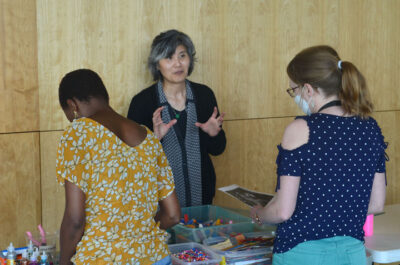Galt Museum presentation teaches expression through archival images
By Ry Clarke on July 27, 2022.
 Herald Photo by Ry Clarke
The Galt Museum hosted a workshop Friday on appropriation and community art, taught by Raeann Cheung whose work, We Are Immigrants, is currently on display at the Museum.
Herald Photo by Ry Clarke
The Galt Museum hosted a workshop Friday on appropriation and community art, taught by Raeann Cheung whose work, We Are Immigrants, is currently on display at the Museum.The Galt Museum held a workshop Friday afternoon learning from Raeann Cheung the techniques needed to create archival image-based artworks.
Grounded in her work on display in the Galt’s exhibit, We Are Immigrants, until Oct. 9, the seminar looked to show techniques that express understanding for cultural history and how we view appropriating.
Cheung, a Chinese immigrant from Hong Kong, is a photographer leaning on her heritage to create personal pieces that showcase her understanding of being a Chinese-Canadian while incorporating ethnicity and awareness. With an MA in Contemporary Photography from Falmouth University, Cheung aims to create bodies of work that complement her heritage while sparking discussion on the hardships of being an immigrant in Canada.
We Are Immigrants delves into the complexities of the hidden hardships and legacy of early Chinese Immigrants appropriating archival images from around Lethbridge in earlier times while adding layers of subtext through alterations and image reconstruction.
“I began this project, We Are Immigrants, when I was prompted to think about my own immigration experience. My family was living in Victoria at the time, in the mid-1970s, and in my own experience there was definitely racism in the neighbourhood. It felt like it was something that was just always lurking around the corner,” said Cheung, delving into her journey.
“I know that some of you might question the validity behind altering someone else’s artwork. But let me assure you this method actually has been used for a very long time.
“We see it in advertising, we see it in music, and we see it in everywhere. Appropriation, according to the Museum of Modern Art, is the intentional borrowing, copying, and alteration of existing images of objects, a strategy that has been used by artists for millennia.”
Cheung speaks on what appropriation is in relation to her work, hoping to teach appropriate ways to take historical images and showcase a subtext through alteration while still paying tribute to the history encapsulated within the pieces.
Cheung discusses the way artists deliberately experiment with images. Using her work as an example, Cheung shows how an image of a Chinese herbalist was altered with tea leaves, adding the element of their craft to the profile.
Speaking towards other methods, Cheung discusses how images of the Marlboro Man have been altered to showcase the history of the American Cowboy, deconstructing an archetype for consumerism.
Showing audiences how techniques alter an image should not be random and instead present through new meaning in an already existing piece.
“I’m hoping that, first of all, if they don’t already know about the history, they might look it up and read a little bit about it. But secondly, to look into their own heritage, and if they don’t know how their ancestors came to Canada, to go and find out. I think it would be beneficial for everyone to know why they came, how they came, and how history hasn’t really changed around economic immigrants,” said Cheung, exploring the meaning behind her own work.
Audience members were given a chance to participate with the techniques taught by Cheung, showcasing their own thoughts and meaning with photography-alteration displaying feminism, family-history, and race in their own ways.
“We Are Immigrants is a long-term project, and part of that project is to involve exploring heritage by way of community participation.
“Except for the Indigenous populations, everyone is an immigrant or a descendant.
“By writing or making art about heritage, there’s an opportunity to heighten our awareness,” said Cheung, hoping to communicate diversity and equality through her work.
“With the help of appropriation to tell our unique stories, I’m hoping that this work will prompt others to think about their heritage, where their ancestors came from, and hopefully, that we are all equal from that perspective.”
18-17


